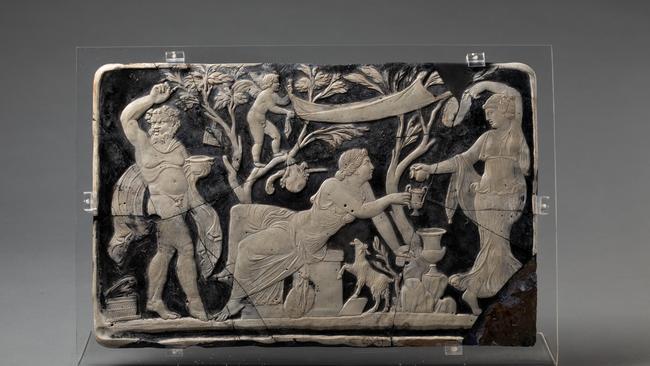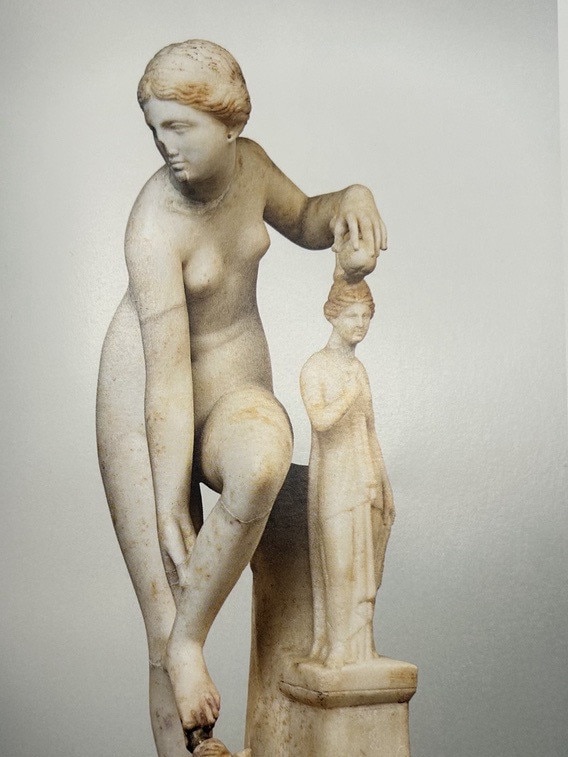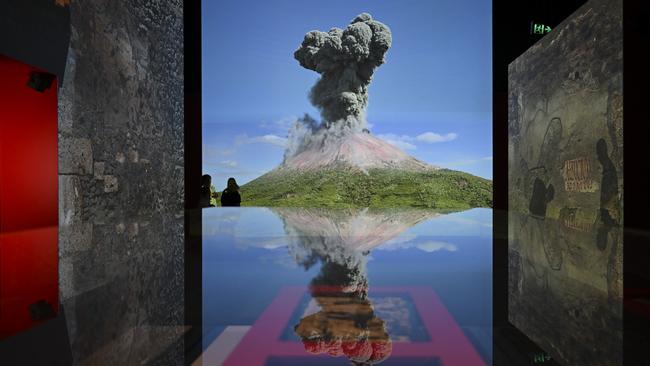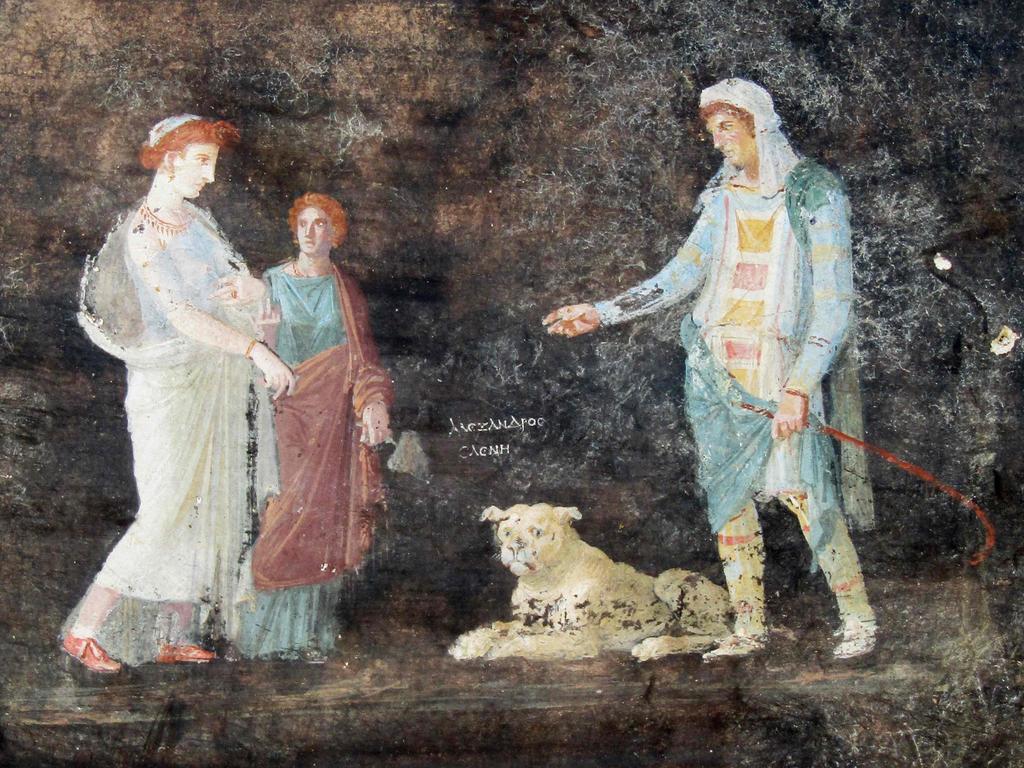Tantalising echoes of everyday city
A bronze statue of Apollo is one of the most remarkable pieces in an exhibition offering vivid glimpses into the world of ancient Pompeii

The Roman Empire has never ceased to fascinate the world, even after the fall of its western half 1½ millennia ago. And with good reason: Rome established the most extensive empire the world had yet seen, encompassing the whole of the Mediterranean region. Although it was built on military power and could never let down its guard, especially in the face of the Germanic tribes outside the empire, it offered centuries of peace, security and prosperity to millions of people living within its borders. When it fell, the barbarian invasions that ensued led to hundreds of years of chaos, endemic violence and cultural regression.
At the same time, Rome, even in defeat, eventually civilised its barbarian conquerors; tribal Celts and Germans in time created modern Europe by emulating the great empire they had conquered, and in the process became heirs to the even more important civilisation of Greece that the Romans had assimilated.

This is a historic pattern repeated wherever great civilisations are overrun by barbarians, and if the process took longer in Europe than when the barbarian Turks came to power in Persia or the Mongol hordes invaded China and Persia, it is probably because Rome was already in a state of decadence when the invaders arrived.
The ruins of Rome remained, and still stand, as a vestige and symbol of past glory, celebrated by countless poets from Petrarch onwards, inevitably reflecting on time and fate and the passing of all human things, but also on the stupendous grandeur of a city that even in its dilapidation was more impressive than any modern rival. These great ruins stood largely intact because the historical centre of Rome was virtually abandoned after its conquest, for the cutting of its aqueducts made much of it uninhabitable.
The city thus remained, in monumental and tragically ruined state, to inspire awe in later centuries, whereas Naples, for example, which was never abandoned, simply was renewed and rebuilt over its ancient footprint. The wonder of Naples, less immediately apparent, is that the street plan of its historic centre has remained unchanged since the Hellenistic age.
Rome was a backwater when the Renaissance began but rapidly revived after the capable Pope Nicholas V restored the first of the ancient aqueducts in 1453: this was the Acqua Vergine, which today is best known from the Trevi Fountain, but also supplies water to the fountains in front of the Pantheon, in the Piazza del Popolo and elsewhere. Within a generation, the resurgence of modern Rome would make it the centre of the High Renaissance.

But this was also the paradox of the modern city, a monument to the greatness of the ancient world yet ruled by the church. “It was at Rome,” as Edward Gibbon recalled, “on the 15th of October, 1764, as I sat musing amidst the ruins of the Capitol, while the barefooted friars were singing vespers in the Temple of Jupiter, that the idea of writing the decline and fall of the city first started to my mind.”
Only the year before, however, the name of the city of Pompeii had been discovered in excavations started around the middle of the century (digging had begun even earlier at Herculaneum, but both the depth and the nature of the volcanic material covering Pompeii made it a much easier site to excavate). And Pompeii would provide another kind of window into the ancient world, not awe-inspiring ruins but the remains of a living city suddenly buried and preserved, unknown, for almost two millennia.
Although excavations have now been going on for 2½ centuries, much remains to be found and studied; about a third of the city of Pompeii remains buried, a good thing since ancient sites become vulnerable to weather and deterioration from many causes once they are exposed. It is ultimately more important to stabilise and conserve what has been found than to dig up more structures in a careless way, yet there is no doubt that fresh discoveries elicit renewed interest and probably help to attract additional funding.
At any rate, the most recent campaign at Pompeii has brought to light some surprising and impressive paintings – some of which I wrote about in this column previously (June 1-2, 2024), and an article on the BBC website a few weeks ago discusses further discoveries, including a new complex that included a commercial laundry and bakery as well as the house of the presumed owner of these businesses, opulent enough to include an impressive private bath house, possibly the grandest in the city.
All of these discoveries also can be seen in a new BBC documentary series, Pompeii: The New Dig.
The current exhibition at the National Museum in Canberra, originally put together by the Parco Archeologico di Pompei in collaboration with the Grand Palais in Paris but here including a largely different set of objects, offers a compact but vivid series of glimpses into the world of the ancient city, if you can bear the compulsory immersive dimension that museum exhibitions all seem to have adopted these days – indeed the original title of the exhibition when shown in Paris in 2020 was Pompei immersif.
The main space of the exhibition is meant to be a street in the city, down the end of which we see a projected digital view of Mount Vesuvius before the eruption in AD79 – it had a very different shape in those days and had been dormant for so long that no one knew it was a volcano. Every 15 minutes we hear a deep rumbling, the mountain explodes, a column of ash and stone erupts into the sky, then collapses, virtually burying us in heaps of pumice and volcanic dust.
In the middle of all this stands one of the most remarkable pieces in the exhibition, a bronze statue of Apollo dating to the first century AD but executed in a style reminiscent of the archaic Greek kouros type of five centuries earlier.
This was not, therefore, simply the conventional statue that a rich Roman might have acquired to adorn his garden but an unusual work demonstrating the sophisticated antiquarian taste of its owner; such an aesthetic choice is all the more interesting when we realise that the statue comes from the house of a wealthy citizen, Caius Julius Polybius, probably the son of Gaius Julius Polybius, a highly learned freedman and research assistant of Emperor Claudius. Perhaps this statue once belonged to Polybius’s famous father.

Other fine sculptural pieces include a marble statuette of Venus (Aphrodite) removing a sandal before bathing – an activity that explains her nakedness, evokes appropriate erotic connotations and at the same time reminds us of her birth from the sea.
There is also a pair of outstanding carved glass cameo plaques of Bacchus (Dionysus) and Ariadne; the first shows a distinctly epicene Bacchus discovering Ariadne asleep on the island of Naxos after her abandonment by Theseus, and the second seems to show Ariadne attended by a dancing satyr and a maenad who fills her cup with wine, while little Erotes or Amorini suspend a canopy above to shade her from the sun.
These exquisite cameos were originally set into a piece of furniture; another example of outstanding workmanship in the domestic setting of wealthy homes is a touching carving of Silenus holding the infant Bacchus. The exhibition also includes carved double-headed herms and ornamental marble reproductions of theatres masks, of the kind discussed recently in my review of the outstanding Theatre in the Roman world exhibition at the Ara Pacis museum in Rome (October 19-20, 2024).

One of the most interesting sections of the exhibition is devoted to the fresco decorations that are such an extraordinary part of the architecture of Pompeii – as they would be 1 ½ millennia later in Renaissance Italy – particularly in the houses of the wealthy, but even on a less ambitious scale in bars and brothels.
The exhibition includes several original frescoes in different styles, as well as high-resolution digital projections of some of the most famous paintings and, in another section on the history of the excavations, recent discoveries such as the Leda and the Swan image that I discussed in my earlier article.
The most beautiful of the frescoes is a garden scene from the so-called House of the Golden Bracelet, presumed to have been painted in the early first century AD, in the reign of Tiberius but recalling the famous garden fresco from the House of Livia, about a half-century earlier and today in the Museo Nazionale Romano in Rome.

Livia’s garden fresco was in her dining room, but this one came from a small room with gardens painted on three sides, perhaps a study where the master of the house could still enjoy the pleasures of nature even while taking care of business correspondence (the illustration shows the south wall, although the fresco in the exhibition itself is from the north wall).
The Pompeii garden scene, though similarly filled with birds and plants, is more complex and less naturalistic, with painted theatre masks hanging at the top and small grisaille panels set on marble herms with incongruously naturalistic heads.
The whole effect is sophisticated, somewhat mannered and self-consciously aesthetic, with understated notes of eroticism in the bare-breasted and sleeping or reclining female figures.
Like the elegant bronze Apollo in Julius Polybius’s dining room, this is not just an indulgence or a straightforward display of wealth and status but also reflects the owner’s more complex and nuanced pride in his own refinement and erudition.
The other very striking original fresco in the exhibition is a large winged female figure, presumably a symbol of Nike, naked to the waist, around which she wears an elaborate sash; in contrast to this and the well-defined, if melancholy features, the upper part of her torso is notably blank and featureless.

This may be due to losses in the original surface, but it is tempting to suspect that while the surviving parts were painted in “buon fresco” – pigments applied to damp plaster – a final layer, including perhaps more anatomical definition and a diaphanous tunic – could have been added later, “a secco”. There are many examples of this practice in the Italian Renaissance and inevitably the layers painted on to a dry surface flake off in time.
Other beautiful objects include the Nymphaeum from a garden, and many items evoking the daily life of the city’s population, rich and poor alike. These add another layer of pathos to the selection of the famous casts taken from hollows in the ash – or rather reproductions of the original plasters, which can no longer be sent abroad – reminding us that it was on a day like any other that the city was overwhelmed by natural catastrophe; loaves were still rising in the ovens of bakeries when time stopped for the inhabitants of Pompeii.
Pompeii, National Museum of Australia, Canberra, to May 4.







To join the conversation, please log in. Don't have an account? Register
Join the conversation, you are commenting as Logout